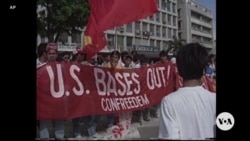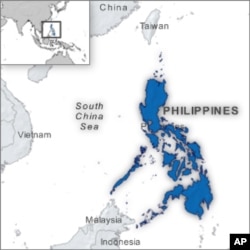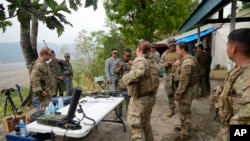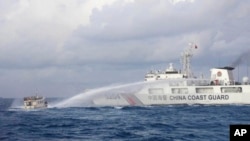Naval Base Camilo Osias, a small military facility on the northern tip of the Philippines’ largest island, does not look important.
On a quiet afternoon in mid-December, just a handful of Philippine navy personnel mingle at its tiny barracks and mostly empty airplane hangar.
Nearby, a rusted anti-aircraft gun, lying partially assembled on a concrete pedestal near a basketball court, is the only visible weapon.
Despite appearances, this site is evidence of an evolving U.S.-Philippine relationship expected to have substantial impact on Asian security.
With U.S. funding, Naval Base Camilo Osias is expected to soon get a rehabilitated airstrip, a new pier and more facilities to accommodate soldiers.
The U.S. military can also rotate troops and place weapons at this strategic location, just 400 kilometers from Taiwan.
It isn't the only site where this is happening.
The U.S. military recently gained access to two other locations near Taiwan, and one facing the disputed South China Sea, under an expansion of a bilateral deal known as the Enhanced Defense Cooperation Agreement, or EDCA.
Nine sites across the Philippines are now covered under the defense pact, originally signed in 2014.
The agreement does not establish permanent U.S. bases, but it does give the U.S. military a bigger presence that could be important if a conflict were to break out in nearby Taiwan or the South China Sea.
Complicated history
EDCA is the latest development in a long and complicated relationship between the United States and the Philippines.
The Philippines was ruled as a U.S. territory from 1898 to 1946, before gaining independence. In 1951, the two countries agreed to a mutual defense treaty, establishing the oldest U.S. defense treaty alliance in Asia.
The United States retained a permanent military presence until the early 1990s, when the last U.S. base was removed amid domestic opposition and concerns about Philippine sovereignty.
Since then, the Philippines has gradually welcomed back visiting U.S. forces under a pair of bilateral agreements, including EDCA.
This trend intensified under President Ferdinand Marcos Jr., who has aligned his country more closely with the United States since taking office in 2022.
Closer ties with the US
This year, U.S. and Philippine forces held their biggest combined military exercise ever and resumed joint patrols in the South China Sea after a long hiatus. The two sides also convened a series of high-level diplomatic and security meetings.
“We’ve seen a dramatic improvement in U.S.-Philippine relations over the course of the last year and a half,” a U.S. diplomat in Manila told VOA. However, the diplomat added, “even if we hadn’t redoubled our efforts and gone all out on the U.S. part, we’d probably still be doing pretty well, because the Chinese have done almost everything wrong.”
In recent months, China has escalated its harassment of Philippine vessels, using water cannons and military-grade lasers, in disputed areas of the South China Sea.
Philippine officials are also worried about the danger of conflict in Taiwan, especially as China ramps up its threats against the self-ruled island.
Earlier this year, China’s ambassador to the Philippines, Huang Xilian, drew condemnation when he appeared to issue a veiled threat against the tens of thousands of overseas Philippine workers in Taiwan.
While criticizing the EDCA agreement, Huang said Manila should “unequivocally oppose” Taiwanese independence if it genuinely cared about the fate of the 150,000 Filipinos working there.
Philippine priorities
Philippine officials have said the revamped EDCA sites, especially those in the north, could be useful for evacuating Filipinos from Taiwan in the event of a war.
The bases could also help facilitate U.S. humanitarian responses to strong typhoons, which often pummel the northern Philippines.
The main priority, though, is military modernization, Jonathan Malaya, assistant director general of the Philippines National Security Council, told VOA in an interview in his office in mid-December.
“We have improved our military ... but it’s never enough. It’s never enough because of the territorial issues we have with China,” Malaya said.
Malaya said the presence of U.S. troops could serve as a deterrent against China’s expansionist goals, especially as Beijing seeks to extend its influence past the so-called first island chain of Pacific archipelagos.
“And that first island chain [includes] both Taiwan and the Philippines, no? So with American troops rotating in the Philippines, it becomes a problem for them,” he said.
As evidence, Malaya cited China’s 1995 seizure of the contested Mischief Reef, which occurred shortly after the U.S. military removed its last permanent base from the Philippines.
“When that happened, the Chinese saw an opportunity and took over,” later turning the tiny ring-shaped island into a “heavily militarized forward operating base,” he said.
Local worries
China has responded angrily to the U.S.-Philippines basing agreement, saying the move jeopardizes regional peace and stability.
That worries Manuel Mamba, the governor of Cagayan Province, where two EDCA sites are located.
“Ten hours after the attack on Pearl Harbor, Japan attacked us, basically because U.S. forces were here. And I think that will happen again if we have foreign forces within our midst,” Mamba told VOA.
Marcos has insisted the EDCA sites will not be used to target any other country and Philippine officials have repeatedly stressed that the agreement allows Manila to veto any use of EDCA that is not in the country’s national interest.
Those assurances are worth little to Mamba, though, who said Marcos or any other future Philippine president may not be able to resist pressure from a much more powerful United States, especially during a crisis.
“It may not be his call when the time comes,” Mamba said. “Sometimes you cannot say no.”
Asked about such concerns, MaryKay Carlson, the U.S. Ambassador to the Philippines, told VOA that the United States respects the Philippines' territorial integrity.
She noted Marcos’ public vow that the Philippines will not “abandon even one square inch of territory” to a foreign power.
“We have heard President Marcos loud and clear,” Carlson said. “It’s actually the People’s Republic of China that has established militarized bases within the exclusive economic zone of the Philippines.”












